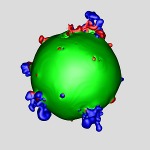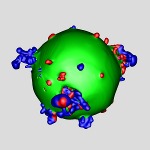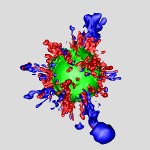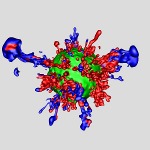 |
|
Fig. 1:
Three-dimensional explosion simulation about 0.5 seconds after
core bounce. The bluish, nearly transparent surface is the shock front
with an average radius of 1900 km.
Copyright: Max Planck Institute for Astrophysics
|
 |
|
Fig. 2:
These snap-shots show the outward mixing of certain elements
in the supernova explosion from two different viewing directions, 350
seconds after core bounce in the upper two panels and after 9000 seconds
in the lower two panels, when the shock has broken out of the stellar
surface. The surfaces denote the radially outermost locations of carbon
(green), oxygen (red), and nickel (blue) with a constant mass fraction.
Copyright: Max Planck Institute for Astrophysics
|
 |
 |
|
Fig. 3:
The Cassiopeia A nebula is the gaseous remnant of a supernova
explosion whose light reached the Earth around the year 1680. The
asymmetries and filamentary structure of this expanding cloud of stellar
debris are a consequence of the clumping and mixing processes that also
played a role in Supernova 1987A and that were simulated for the first
time in all three dimensions by the team at the Max Planck Institute for
Astrophysics.
Credit: X-ray: NASA/CXC/SAO; Optical: NASA/STScI; Infrared: NASA/JPL-Caltech/Steward/O.Krause et al.
|
|  |
Massive stars end their lives in gigantic explosions, so called
supernovae, and can become — for a short time — brighter
than a whole galaxy, which is made up of billions of stars. Although
supernovae have been studied theoretically by computer models for
several decades, the physical processes happening during these blasts
are so complex that astrophysicists until now can simulate only parts of
the process and so far only in one or two dimensions. Researches at the
Max Planck Institute for Astrophysics in Garching have now carried out
the first fully three-dimensional computer simulations of a core
collapse supernova over a timescale of hours after the initiation of the
blast. They thus could answer the question how initial asymmetries,
which emerge deep in the dense core during the very early stages of the
explosion, fold themselves into inhomogeneities observable during the
supernova blast.
While the great energy of the outburst makes these stellar explosions
visible far out into the Universe, they are relatively rare. In a galaxy
of the size of our Milky Way, on average only one supernova will occur
in 50 years. About twenty years ago, a supernova could be seen even with
the naked eye: SN 1987A in the Tarantula Nebula in the Large Magellanic
Cloud, our neighbouring galaxy. This relative closeness —
”only“ about 170 000 light years away — allowed many
detailed observations in different wavelength bands over weeks and even
months. SN 1987A turned out to be a core-collapse supernova, a so-called
Type II event. It occurs when a massive star, which is at least nine
times heavier than the sun, has burned almost all its fuel. The fusion
engine in the centre of the star begins to stutter, triggering an
internal collapse and thus a violent explosion of the entire star. In
the case of SN 1987A the star had about 20 solar masses at its birth.
SN 1987A is probably the best studied supernova and it is still a great
challenge to develop and refine models of what was happening inside the
dying star to produce its emission of radiation. One of the astonishing
and unexpected discoveries in SN 1987A and many subsequent supernovae
was the fact that nickel and iron — heavy elements that are formed
near the centre of the explosion — are mixed outward in big clumps
into the hydrogen shell of the disrupted star. Nickel bullets were
observed to propagate at velocities of thousands of kilometres per
second, much faster than the surrounding hydrogen and much faster than
predicted by simple hydrodynamic calculations in one dimension (1D),
i.e., only studying the radial profile from the centre outwards.
In fact, it turned out that the brightness evolution (the so-called
light curve) of SN 1987A and of similar core-collapse supernovae can
only be understood if large amounts of heavy core material (in
particular radioactive nickel) are mixed outwards into the stellar
envelope, and light elements (hydrogen and helium from the envelope) are
carried inwards to the core.
The details of supernova explosions are very difficult to simulate, not
only because of the complexity of the physical processes involved but
also because of the duration and range of scales — from hundreds
of metres near the centre to tens of millions of kilometres near the
stellar surface — that need to be resolved in ultimately three-
dimensional (3D) computer models. Previously conducted simulations in
two dimensions (2D, i.e., with the assumption of axial symmetry) indeed
showed that the spherical shell structure of the progenitor star is
destroyed during the supernova blast and large-scale mixing takes place.
But the real world is three-dimensional and not all observational
aspects can be reproduced by 2D models.
The new computer models of the team at the Max Planck Institute for
Astrophysics now simulate for the first time the complete burst in all
three dimensions, from the first milliseconds after the explosion is
triggered in the core to a time three hours later, when the shock breaks
out of the progenitor star. ”We found substantial deviations in
our 3D models compared to previous work in 2D,“ says Nicolay
Hammer, the lead author of the paper, ”especially the growth of
instabilities and the propagation of clumps differ. These are not just
minor variations; this effect determines the long-time evolution and
ultimately the extent of mixing and observable appearance of core-
collapse supernovae.“
In the 3D-simulations, metal-rich clumps have much higher velocities
than in the 2D case. These ”bullets“ expand much more
rapidly, overtaking material from the outer layers. ”With a simple
analytic model we could demonstrate that the different geometry of the
bullets, toroidal versus quasi-spherical, can explain the differences
observed in our simulations,“ explains co-author Thomas Janka.
”While we think that the differences between the 2D- and 3D-models
that we found are probably generic, many features will depend strongly
on the structure of the progenitor star, the overall energy and the
initial asymmetry of the blast.“
”We hope that our models, in comparison to observations, will help
us to understand how stellar explosions start and what causes
them“, adds Ewald Müller, the third author of the paper.
Investigating a wider variety of progenitor stars and initial conditions
will therefore be the focus of future simulation work. In particular, a
detailed model that reproduces all observational features of SN 1987A
still remains a challenge.
Original publication
N.J. Hammer, H.-Th. Janka, E. Müller,
"Three-dimensional simulations of mixing instabilities in supernova explosions",
The Astrophysical Journal 714 (2010) 1371-1385
Links to movies
 Computer simulation of the first 500 milliseconds
(Source: Leonhard Scheck, Max Planck Institute for Astrophysics) Computer simulation of the first 500 milliseconds
(Source: Leonhard Scheck, Max Planck Institute for Astrophysics)
 Computer simulation up to 9000 seconds
(Visualisation: Markus Rampp, Rechenzentrum Garching) Computer simulation up to 9000 seconds
(Visualisation: Markus Rampp, Rechenzentrum Garching)
Contact
Dr. Hannelore Hämmerle
Press Officer
Max Planck Institute for Astrophysics
and Max Planck Institute for extraterrestrial Physics
Phone: +49 89 30000-3980
E-Mail: hhaemmerle mpa-garching.mpg.de mpa-garching.mpg.de
|








 mpa-garching.mpg.de
mpa-garching.mpg.de